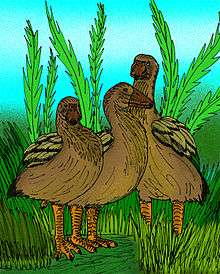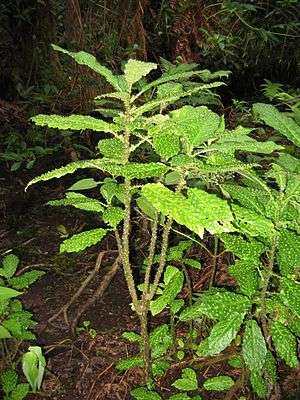Moa-nalo
| Moa-nalo Temporal range: Late Pleistocene to Holocene | |
|---|---|
| | |
| Artist's conception of Thambetochen chauliodous, and Ptaiochen pau | |
| Scientific classification | |
| Kingdom: | Animalia |
| Phylum: | Chordata |
| Class: | Aves |
| Order: | Anseriformes |
| Family: | Anatidae |
| Subfamily: | Anatinae[1] |
| Tribe: | Thambetochenini |
| Genera | |
The moa-nalo are a group of extinct aberrant, goose-like ducks that lived on the larger Hawaiian Islands, except Hawaiʻi itself, in the Pacific. They were the major herbivores on most of these islands for the last 3 million years or so, until they became extinct after human settlement.
Description
The moa-nalo (the name literally means "lost fowl"; an "s" is not added for the plural) were unknown to science, having been wiped out before the arrival of Captain James Cook (1778), until the early 1980s, when their subfossil remains were discovered in sand dunes on the islands of Molokaʻi and Kauaʻi. Subsequently, bones were found on Maui, Oʻahu, and Lānaʻi, in lava tubes, lake beds, and sinkholes. They represent four species in three genera so far:
- Chelychelynechen quassus (turtle-jawed moa-nalo) from Kauaʻi
- Ptaiochen pau (small-billed moa-nalo) from Maui
- Thambetochen xanion (O'ahu moa-nalo) from Oʻahu
- Thambetochen chauliodous (Maui Nui large-billed moa-nalo) from Maui, Lānaʻi and Molokaʻi (Maui Nui)
Chelychelynechen, meaning turtle-jawed goose, had a large, heavy bill like that of a tortoise, while the other two genera, Thambetochen and Ptaiochen, all had serrations in their bills known as pseudoteeth, similar to those of mergansers. All species were flightless and large, with an average mass of 4–7.5 kg (8.8–16.5 lb).
Evolution

.jpg)
Some moa-nalo fossils have been found to contain traces of mitochondrial DNA which were compared to living duck species in order to establish their place in the duck family, Anatidae.[1] Contrary to the expectations of some scientists, the moa-nalo were not related to the large geese (Anserinae), such as the surviving nēnē, but instead to the dabbling ducks of the genus Anas, which includes the mallard. The present DNA analysis' resolution is not high enough to determine their relationships to different species of Anas, but biogeography strongly suggests that their closest living relative is the widespread Pacific black duck.
From the DNA sequences it has been estimated that the ancestors of the moa-nalo reached the Hawaiian Islands about 3.6 million years ago, by which time the genus Anas was already distributed worldwide. There they increased in size, but must have retained the ability to fly until they had spread to the newer islands. They seem to have lost the power of flight by the time the main island of Hawaiʻi had emerged from the sea (400,000 years ago); there, their niche was filled by one or two species of now extinct giant Branta goose presumably related to the surviving nēnē.
Ecology

The unusual shape and size of the moa-nalo can be attributed to their role in the ecology of prehistoric Hawaiʻi. A study of coprolites (fossil dung) of Thambetochen chauliodous found in Puʻu Naio Cave on lowland Maui has shown they were folivorous, at least in dry shrub or mesic forest habitats eating particularly fronds from ferns (possibly Asplenium nidus or Dryopteris wallichiana). This conclusion is backed up by the shapes of their beaks (James & Burney 1997). This indicates they were the principal browsers on the island. The presence of prominent spines on the leaves and soft young stems of several Hawaiian lobelioids in the genus Cyanea—unusual in an island flora where such defenses are frequently lost, as in the ʻākala (Hawaiian raspberry)—suggests that the Cyanea evolved these thorn-like prickles on new growth because they protect against browsing by the moa-nalo. The moa-nalo themselves filled the niche of herbivore usually filled by mammals such as goats and deer, or the giant tortoises of Galápagos and other archipelagoes. This has implications for the ecology of Hawaiian Islands today, as a major group of species have been lost.
The moa-nalo became extinct after the arrival of Polynesian settlers in the islands, along with many other species; because the flightless birds must have been considered a prime source of meat, probably around 1000 AD or even earlier. Like island taxa from Mauritius, New Zealand and Polynesia, they were unused to mammals and were easily taken by hunters or the animals that were introduced and became feral, such as domestic pigs.
See also
- Giant tortoises, found on several archipelagos around the world
- Island gigantism
- Late Quaternary prehistoric birds
- Moa, enormous extinct flightless ratites, formerly the largest herbivores in New Zealand
References
- 1 2 Sorenson, Michael D. (July 1999). "Relationships of the ancient moa-nalo-nalos (sic), flightless Hawaiian waterfowl, based on ancient DNA" (PDF). The Royal Society. 266: 2187–2193.
- James, Helen F. & Burney, David A. (1997): The diet and ecology of Hawaii's extinct flightless waterfowl: evidence from coprolites. Biol. J. Linn. Soc. 62(2): 279–297. HTML abstract
- Sorenson et al. (1999): Relationships of the extinct moa-nalos, flightless Hawaiian waterfowl, based on ancient DNA. Proceedings of the Royal Society. On-line at .
- Slikas, Beth (2003): Hawaiian Birds: Lessons from a Rediscovered Avifauna. Auk 120(4): 953-960. DOI: 10.1642/0004-8038(2003)120[0953:HBLFAR]2.0.CO;2